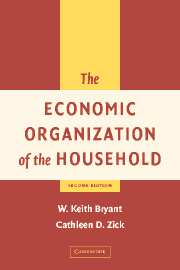Book contents
- Frontmatter
- Contents
- List of Figures
- Preface to the Second Edition
- 1 Introduction
- 2 Household Equilibrium
- 3 The Analysis of Consumer Demand
- 4 Consumption and Saving
- 5 Work and Leisure : How the Household Spends Its Time
- 6 Human Capital : Investing in Oneself and One's Family
- 7 The Economics of Fertility
- 8 The Economics of Marriage and Divorce
- References
- Index
5 - Work and Leisure : How the Household Spends Its Time
Published online by Cambridge University Press: 06 July 2010
- Frontmatter
- Contents
- List of Figures
- Preface to the Second Edition
- 1 Introduction
- 2 Household Equilibrium
- 3 The Analysis of Consumer Demand
- 4 Consumption and Saving
- 5 Work and Leisure : How the Household Spends Its Time
- 6 Human Capital : Investing in Oneself and One's Family
- 7 The Economics of Fertility
- 8 The Economics of Marriage and Divorce
- References
- Index
Summary
INTRODUCTION
During the first half of the twentieth century, American males in nonagricultural employment reduced the average annual weekly hours they worked from 60 hours per week to about 40. This change took the form of a reduced workweek, longer annual vacations, and more holidays (Costa 2000; Owen 1970). At the same time, men also reduced the fraction of their lives they spent working in the labor market from 0.23 in 1900 to 0.15 in 1960 (Owen 1970). During the second half of the twentieth century, males' weekly work hours have remained relatively stable, hovering between 40 and 42 hours per week (Herman 1999). But, the proportion of males who worked full-time year-round declined from 72 percent in 1969 to 57 percent by 1997 (Herman 1999). Although some of this reduction in male labor supply is the result of lengthened life expectancy, also important is the increased amount of time spent in school and in retirement. For instance, in 1950, the average age of retirement for American men was 70. By 1985, it had dropped to 63 and it has remained near 63 through 1999 (Burtless and Quinn 2000).
The work patterns of American females have also undergone revolutionary changes over the past 100 years. The labor force participation rate of married females was approximately 4.5 percent in 1900 (Lebergott 1968).
- Type
- Chapter
- Information
- The Economic Organization of the Household , pp. 125 - 197Publisher: Cambridge University PressPrint publication year: 2005



